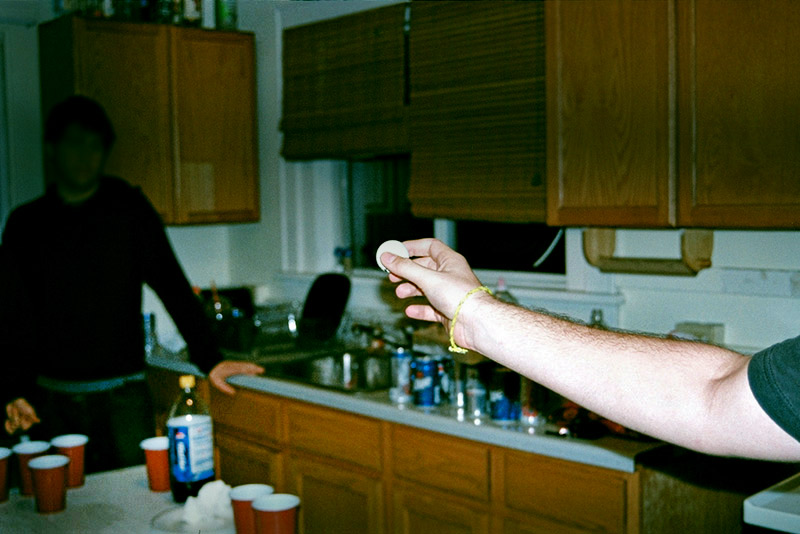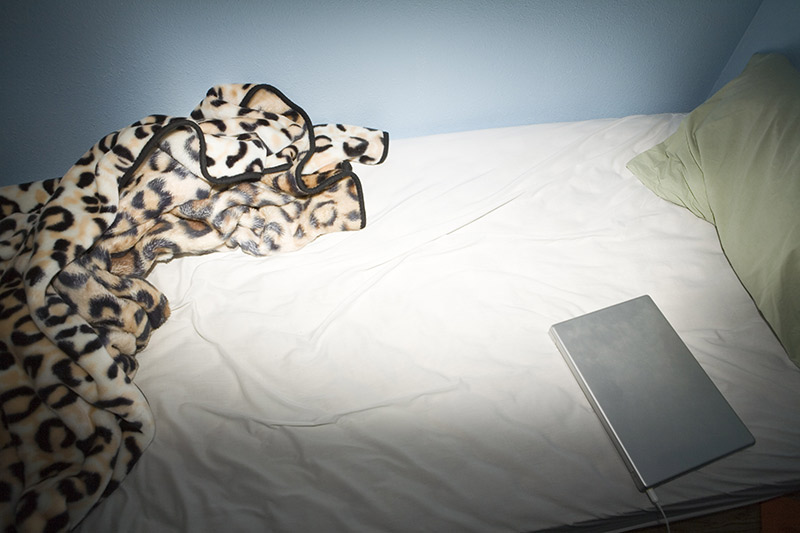Drew Sterrett couldn’t know that when his friend slipped into his bottom bunk late one night in March of his freshman year, she was setting off a series of events that would end his college education. It was 2012, and Sterrett was an engineering student at the University of Michigan. The young woman, CB, lived down the hall. A group of students had been hanging out in the dorm on a Friday evening—there was drinking, but no one was incapacitated—when CB told Sterrett that her roommate had family members staying in their room and she needed a place to spend the night. Sterrett loaned her a shirt to sleep in and assumed she’d crash on the mat he and his roommate kept for visitors. Instead, CB came and lay down next to him on his bed. The two had made out in the past but had no serious romantic interest in each other.
They talked quietly, started kissing, and then things escalated, as they often do when two teenagers are in bed together. When it became clear they were going to have intercourse, CB asked Sterrett about a condom, and he retrieved one from a drawer. Their sex became so loud and went on for so long that Sterrett’s roommate, unable to sleep in the upper bunk, sent Sterrett a Facebook message around 3 a.m.: “Dude, you and [CB] are being abnoxtiously [sic] loud and inconsiderate, so expect to pay back in full tomorrow …”
The two finally finished and went to sleep. The next morning, Sterrett says CB told him that she wanted to keep their interlude private. He thought she was embarrassed that she’d had sex with a friend and agreed not to talk to others about it. They saw each other frequently in the dorm until the school year ended.
Sterrett was home in New York for the summer when he was contacted by a university official, Heather Cowan, program manager of the Office of Student Conflict Resolution, and told to make himself available for a Skype interview with her and another administrator. No reason was given.
As the interview got under way, Sterrett realized that CB must have told Cowan something disturbing about their one-time assignation. Becoming concerned about the tenor of the questions, he asked the administrators if he should consult a lawyer. He says they told him that if he ended the interview in order to seek counsel that fact would be reported to the university and the investigation would continue without his input. He kept talking. He told Cowan that he and CB had had a consensual encounter while his roommate was only a few feet away. As the interview was coming to a close, Sterrett says the administrators told him this matter was confidential—though he’d still not been explicitly told what the matter was—and that he should not talk to anyone about it, especially not fellow students who might be witnesses on his behalf.

Courtesy of Jeffrey Smith/Flickr
Later, Sterrett would consult a lawyer and file a lawsuit against the university alleging he’d been deprived of his constitutional right to due process. This account is drawn from the legal filings in that ongoing case. These include Sterrett’s case against the university, affidavits from witnesses sworn on Sterrett’s behalf, the university’s response, and a deposition of CB taken by Sterrett’s lawyer. (Through his lawyer, Sterrett declined to speak to me. A Michigan spokesman said the university cannot comment on a pending case. CB has remained anonymous in court filings. I contacted her lawyer, Joshua Sheffer, who sent the following statement: “While we strongly disagree with Plaintiff’s description of the night in question, we do not feel that it should be played out in the press.” It continued: “This lawsuit is between Plaintiff and the University of Michigan; my client wishes only to put this traumatic event behind her and move forward with her education and life.”)
Cowan told Sterrett over Skype that there would be restrictions placed on him when he returned to campus for his sophomore year. Sterrett and CB were part of a special program called the Michigan Research Community, and members lived together in a residence hall. Although Sterrett and CB had continued to live on the same floor until the end of the school year, and she hadn’t complained about his presence, Cowan told Sterrett that he would be removed from the dorm. He was also told that he could not be in the vicinity of CB, which meant he was in effect barred from entering the dorm, cutting him off from most of his friends.
The events that prompted the university to take these actions against Sterrett are detailed in an affidavit sworn on Sterrett’s behalf by LC, a friend of CB’s and her sophomore year roommate. LC stated that in July she received a call from an “emotionally upset” CB who explained that her mother had found her diary. LC recalled that CB explained that the diary “contained descriptions of romantic and sexual experiences, drug use, and drinking.” (CB confirmed the contents of the diary in her own deposition.) During the phone call, CB asked LC if she remembered the night CB had sex with Sterrett. LC didn’t, because CB had never mentioned it. Now CB told her, “I said no, no, and then I gave in.” Eventually, as described in CB’s deposition, CB’s mother called the university to report that CB would be making a complaint against Sterrett. CB’s mother drove her to campus, and CB met with Heather Cowan.
We are told that one of the most dangerous places for a young woman in America today is a college campus. As President Obama said at a White House event in September, where he announced a campaign to address campus violence, “An estimated one in five women has been sexually assaulted during her college years—one in five.” (At an earlier White House event on the issue, the president declared of sexual violence, “It threatens our families, it threatens our communities; ultimately, it threatens the entire country.”) In recent weeks, Rolling Stone’s lurid account of a premeditated gang rape at the University of Virginia has made the issue of campus sexual violence front-page news. (The reporting and the allegations in the article have since been called into question, and Rolling Stone has issued a statement acknowledging that the magazine failed to properly investigate and corroborate the story.)
Sexual assault at colleges and universities is indeed a serious problem. The attention it’s receiving today—on campus, at the White House, in the media—is a direct result of the often callous and dismissive treatment of victims. For too long, women who were assaulted on campus and came forward were doubted or dismissed, and the men responsible were given a mild rebuke or none at all. Those who commit serious sexual crimes on campus must be held to account.
In recent years, young activists, many of them women angry about their treatment after reporting an assault, have created new organizations and networks in an effort to reform the way colleges handle sexual violence. They recognized they had a powerful weapon in that fight: Title IX, the federal law that protects against discrimination in education. Schools are legally required by that law to address sexual harassment and violence on campus, and these activists filed complaints with the federal government about what they describe as lax enforcement by schools. The current administration has taken up the cause—the Chronicle of Higher Education describes it as “a marquee issue for the Obama administration”—and praised these young women for spurring political action. “A new generation of student activists is effectively pressing for change,” read a statement this spring announcing new policies to address campus violence. The Department of Education has drafted new rules to address women’s safety, some of which have been enshrined into law by Congress, with more legislation likely on the way.
Unfortunately, under the worthy mandate of protecting victims of sexual assault, procedures are being put in place at colleges that presume the guilt of the accused. Colleges, encouraged by federal officials, are instituting solutions to sexual violence against women that abrogate the civil rights of men. Schools that hold hearings to adjudicate claims of sexual misconduct allow the accuser and the accused to be accompanied by legal counsel. But as Judith Shulevitz noted in the New Republic in October, many schools ban lawyers from speaking to their clients (only notes can be passed). During these proceedings, the two parties are not supposed to question or cross examine each other, a prohibition recommended by the federal government in order to protect the accuser. And by federal requirement, students can be found guilty under the lowest standard of proof: preponderance of the evidence, meaning just a 51 percent certainty is all that’s needed for a finding that can permanently alter the life of the accused.
More than two dozen Harvard Law School professors recently wrote a statement protesting the university’s new rules for handling sexual assault claims. “Harvard has adopted procedures for deciding cases of alleged sexual misconduct which lack the most basic elements of fairness and due process,” they wrote. The professors note that the new rules call for a Title IX compliance officer who will be in charge of “investigation, prosecution, fact-finding, and appellate review.” Under the new system, there will be no hearing for the accused, and thus no opportunity to question witnesses and mount a defense. Harvard University, the professors wrote, is “jettisoning balance and fairness in the rush to appease certain federal administrative officials.” But to push back against Department of Education edicts means potentially putting a school’s federal funding in jeopardy, and no college, not even Harvard, the country’s richest, is willing to do that.
Hard-line policies like Harvard’s are necessary, government officials say, because undergraduate women are in unique peril. Often-cited studies of sexual violence at colleges describe an epidemic. But each of these studies has serious methodological limitations. In some cases, the studies make sensational assertions that are not supported by the underlying data. In others, the experiences of one or two campuses have been made to stand in for the entirety of America’s higher education system.
Sen. Kirsten Gillibrand, D–New York, is a co-sponsor of the bipartisan Campus Accountability and Safety Act, or CASA, expected to be voted on next year. The legislation would, among other things, require all colleges provide a confidential adviser to guide victims through the entire process of bringing an accusation while no guidance or assistance is mandated for the accused. Gillibrand said in announcing the legislation, “We should never accept the fact that women are at a greater risk of sexual assault as soon as they step onto a college campus. But today they are.”
This is one of the frequently made assertions about campus violence, but the evidence to back it up is lacking. Being young does make people more vulnerable to serious violent crime, including sexual assault; according to government statistics those aged 18 to 24 have the highest rates of such victimization. But most studies don’t compare the victimization rates of students to nonstudents of the same age. One recent paper that does make that comparison, “Violence Against College Women” by Callie Marie Rennison and Lynn Addington, compares the crime experienced by college students and their peers who are not in college, using data from the National Crime Victimization Survey. What the researchers found was the opposite of what Gillibrand says about the dangers of campuses: “Non-student females are victims of violence at rates 1.7 times greater than are college females,” the authors wrote, and this greater victimization holds true for sex crimes: “Even if the definition of violence were limited to sexual assaults, these crimes are more pervasive for young adult women who are not in college.”
Rennison, an associate professor at the School of Public Affairs at the University of Colorado Denver, recognized in an interview that her study goes against a lot of received wisdom. “Maybe that’s not a really popular thing to say,” she said, adding, “I hate the notion that people think sending kids off to college is sending them to be victimized.”
Any woman who is raped, on campus or off, deserves a fair and thorough investigation of her claim, and those found guilty should be punished. But the new rules—rules often put in place hastily and in response to the idea of a rape epidemic on campus—have left some young men saying they are the ones who have been victimized. They are starting to push back. In the past three years, men found responsible for sexual assault on campus have filed more than three dozen cases against schools. They argue that their due process rights have been violated and say they have been victims of gender discrimination under Title IX. Their complaints are starting to cost universities. The higher education insurance group United Educators did a study of the 262 insurance claims it paid to students between 2006 and 2010 because of campus sexual assault, at a cost to the group of $36 million. The vast majority of the payouts, 72 percent, went to the accused—young men who protested their treatment by universities.
Assertions of injustice by young men are infuriating to some. Caroline Heldman, an associate professor of politics at Occidental College and co-founder of End Rape on Campus, said of the men who are turning to the courts, “These lawsuits are an incredible display of entitlement, the same entitlement that drove them to rape.” Sen. Claire McCaskill, D-Missouri, a co-sponsor of the CASA bill, said to the Washington Post of these suits, “I don’t think we are anywhere near a tipping point where the people accused of this are somehow being treated unfairly.”
I’ve read through the court filings and investigative reports of a number of these cases, and it’s clear to me that many of the accused are indeed being treated unfairly. Government officials and campus administrators are attempting to legislate the bedroom behavior of students with rules and requirements that would be comic if their effects weren’t frequently so tragic. The legal filings in the cases brought by young men accused of sexual violence often begin like a script for a college sex farce but end with the protagonist finding himself in a Soviet-style show trial. Or, as in the case of Drew Sterrett, punished with no trial at all.
At the beginning of his sophomore year, Drew Sterrett was in limbo. He did not know whether he would face further disciplinary action as a result of the accusation against him, and indeed no formal written charge was ever issued. The single, cryptic Skype interrogation—the one that blindsided Sterrett over his summer vacation—was to be his sole hearing with campus administrators. He never met them in person. Sterrett’s suit against the university accuses it of violating his constitutional right to due process. But as he waited out the fall, often there didn’t seem to be any process.
Through September and October, he heard nothing further about the charge. Unbeknownst to him, CB was having second thoughts, as she explained in a deposition taken as a result of Sterrett’s case against the university, because she wasn’t sure she wanted Sterrett to be able to read her statement against him. The only word he received from school administrators during this period was a warning email from Cowan, in October. One day Sterrett was walking with a friend who was putting his bike away at Sterrett’s old dorm. CB saw him near her residence and contacted Cowan, who informed Sterrett that the visit gave an appearance of “retaliatory contact.” He replied to Cowan and said it was troubling that his mere presence near a residence hall was considered an act of impropriety and asked that the investigation be finished “as quickly and compassionately as possible for everyone involved.”
On Nov. 9, 2012, Sterrett was given a one-page document titled “Summary of Witness Testimony and Review of Other Evidence.” It consisted primarily of summaries of statements from anonymous witnesses. For example, it stated: “Two witnesses stated the Complainant reported to them that she tried to push the Respondent off her.” (CB didn’t know who these two witnesses were. She confirmed in her deposition that in her original statement to Cowan, she never said that she had tried to push Sterrett off her.) It also stated: “[A] witness reported that the Respondent told them that he engaged in penetration with the Complainant and ‘she was saying ‘no,’ and that it was just—it was ‘just like a second,’ and then he stopped, and then the Complainant left.’ ” (In her deposition, CB acknowledged this was not how their sexual encounter transpired, although she maintained that at some point she said “no.”)
The document made clear to Sterrett that CB was claiming that she had said “no” during their encounter. He put together a lengthy rebuttal. Of CB’s claim, he wrote, “I cannot state it more clearly that this is untrue. I asked her if she wanted to have sex; she said ‘yes.’ ” (CB’s assertion was also challenged later by an affidavit sworn on Sterrett’s behalf by his freshman year roommate, the one in the upper bunk. The roommate said that he saw CB get into Sterrett’s bed of her own volition and that his bed and Sterrett’s were so close that he would have heard if she had exclaimed, “no” or “stop.” He stated that he was annoyed that their sex was keeping him awake and that as a friend of both he would have intervened if he felt something untoward was happening.)

Courtesy of Slava/Flickr
Sterrett’s rebuttal also noted that Cowan’s document failed to mention the role CB’s mother played in bringing the accusation against him after she found her daughter’s diary. CB’s roommate, LC, in an affidavit sworn on behalf of Sterrett, said that over the summer CB’s mother had called her repeatedly warning her not to talk to Sterrett and to take CB’s side in all proceedings. LC stated that she never saw any change in CB’s behavior from the time of the alleged assault until the end of freshman year. But, she said, CB’s personality changed dramatically after her mother found her diary and the fall semester began. In her affidavit, LC said it pained her to speak against her friend, but she stated: “It is my belief, based on my personal observations and conversations with CB, that it is possible CB manufactured a story about a sexual assault in response to the conflict CB described occurring between her and her mother in the summer of 2012.”
On Nov. 30, Sterrett received Cowan’s final “Sexual Misconduct Investigation Report.” His lawsuit states that the final report failed to take note of anything he had written in his rebuttal. The final report was longer than Cowan’s previous one, and included further allegations that either CB herself did not corroborate or appeared unsupported by the available evidence. For example, it stated: “The Complainant framed the events in question as a sexual assault to witnesses the day following the event.” In her deposition, CB acknowledged that she didn’t do that, that in fact she’d never used the words “sexual assault” to describe what happened. The report said that Sterrett’s roommate was asleep during the entire sexual encounter. This was contradicted by the time-stamped Facebook message complaining that he was being kept awake.
The report also said that Sterrett had confessed to his roommate that he’d had a nonconsensual encounter with CB. When Cowan interviewed the roommate—who says she never told him the purpose of her investigation—he had mentioned that Sterrett said he regretted the encounter with CB. In Cowan’s report, that statement is described as a confession of sexual violation. But as the roommate clarified in his affidavit, Sterrett was not expressing “that he had done anything morally or legally or ethically wrong.” He was expressing regret for sleeping with someone in their group of friends.
The final report came to this conclusion: “[I]t is determined that the Respondent engaged in sexual intercourse with the Complainant without her consent and that that activity is so severe as to create a hostile environment.” His punishment was that he was suspended from college until July 2016—after CB graduated. In order for the university to consider reinstating him, he would have to agree that he had engaged in sexual misconduct. Whether or not he returned, the finding would stay on his permanent record. Sterrett’s lawsuit says a university official acknowledged to him that these sanctions would “limit his educational, employment and career opportunities.”
With the help of a lawyer, Sterrett filed an appeal to the Office of Student Conflict Resolution. He included affidavits from classmates who said their words had been misconstrued and even falsified, and included the statement by Sterrett’s roommate that CB was a willing participant and that the roommate would have heard and intervened if CB had said no. The university’s response was to stand by its finding that Sterrett was responsible for sexual misconduct but to change the reason. Now Cowan issued an addendum stating that Sterrett had committed sexual misconduct because CB was too drunk to consent. (In her deposition, CB acknowledged that while she had been drinking, she was not incapacitated.)
Upholding the finding that he committed sexual misconduct required Sterrett to leave the university. But he had already decided not to return to school after winter break of his sophomore year. His lawyer explained in an email that Sterrett felt the restrictions put on his movements in order to avoid running into CB—he could be expelled if she saw him and felt his presence was “retaliatory”—made it impossible for him to be at school. Sterrett filed another appeal, this one to Michigan’s university Appeals Board. In July 2013, it upheld the sexual misconduct finding, though it agreed to place Sterrett on disciplinary probation instead of suspension. The probation, however, came with onerous conditions, according to his lawyer: He would now be barred from any university housing and was prohibited from enrolling in any class in which CB was enrolled (and thus prohibited from registering and enrolling in classes until CB had finalized her schedule). He declined to return.
In April of this year, Sterrett filed suit against the university. The suit states that the public university violated his 14th Amendment rights of due process and that Michigan contravened its own procedures for disciplinary hearings, which call for written notice of allegations against a student, sufficient time to prepare for an arbitration or other meeting (Sterrett says there was no arbitration or meeting), knowledge of the names of witnesses, the opportunity to pose questions to the complainant or other witnesses, and more. As a result of these violations, his suit says, he was subjected to a process that was “capricious, reckless, incomplete, [and] lacked fundamental fairness.”
Michigan has asked the United States District Court for the Eastern District of Michigan to dismiss Sterrett’s suit. Its motion to dismiss outlines the university’s version of events. Michigan asserts Sterrett was given fair notice of the charges against him, citing the fact that Sterrett’s own suit stated that he “gleaned” that he was being accused of sexual assault from his Skype interrogation. The motion states that Sterrett was given several opportunities to file his rebuttals and appeals, concluding, “That’s not lack of due process. It’s abundant process.” It also noted that Sterrett decided to file a lawsuit rather than return to the university under the sanctions and restrictions it offered. The statement issued by CB’s lawyer noted, “The University of Michigan thoroughly investigated the matter. Plaintiff and my client each had an opportunity to present evidence. Plaintiff was found responsible; he appealed that decision, and it was upheld.”
I spoke to Sterrett’s lawyer, Deborah L. Gordon. She said that like many similarly accused young men, Sterrett believed that once a responsible investigation was undertaken, everything would be straightened out. “He had no idea he was on his way out no matter what he said or what the facts were,” she said. She hopes to get the case to a jury, but she says the university is making every legal effort to delay. Sterrett should be graduating from college next spring, but the sexual misconduct charge against him has made it virtually impossible for him to be accepted as a transfer student elsewhere. He was accepted to one well-regarded university, but the offer was rescinded when the school heard of his disciplinary finding at Michigan. Now 22, he’s hoping that if his suit is successful, he will be able to finish his education—some day.
One campus rape is one too many. But the severe new policies championed by the White House, the Department of Education, and members of Congress are responding to the idea that colleges are in the grips of an epidemic—and the studies suggesting this epidemic don’t hold up to scrutiny. Bad policy is being made on the back of problematic research, and will continue to be unless we bring some healthy skepticism to the hard work of putting a number on the prevalence of campus rape.
It is exceedingly difficult to get a numerical handle on a crime that is usually committed in private and the victims of which—all the studies agree—frequently decline to report. A further complication is that because researchers are asking about intimate subjects, there is no consensus on the best way to phrase sensitive questions in order to get the most accurate answers. A 2008 National Institute of Justice paper on campus sexual assault explained some of the challenges: “Unfortunately, researchers have been unable to determine the precise incidence of sexual assault on American campuses because the incidence found depends on how the questions are worded and the context of the survey.” Take the National Crime Victimization Survey, the nationally representative sample conducted by the federal government to find rates of reported and unreported crime. For the years 1995 to 2011, as the University of Colorado Denver’s Rennison explained to me, it found that an estimated 0.8 percent of noncollege females age 18-24 revealed that they were victims of threatened, attempted, or completed rape/sexual assault. Of the college females that age during that same time period, approximately 0.6 percent reported they experienced such attempted or completed crime.
That finding diverges wildly from the notion that one in five college women will be sexually assaulted by the time they graduate. That’s the number most often used to suggest there is overwhelming sexual violence on America’s college campuses. It comes from a 2007 study funded by the National Institute of Justice, called the Campus Sexual Assault Study, or CSA. (I cited it last year in a story on campus drinking and sexual assault.) The study asked 5,466 female college students at two public universities, one in the Midwest and one in the South, to answer an online survey about their experiences with sexual assault. The survey defined sexual assault as everything from nonconsensual sexual intercourse to such unwanted activities as “forced kissing,” “fondling,” and “rubbing up against you in a sexual way, even if it is over your clothes.”

Courtesy of Maria Casacalenda/Flickr
There are approximately 12 million female college students in the U.S. (There are about 9 million males.) I asked the lead author of the study, Christopher Krebs, whether the CSA represents the experience of those millions of female students. His answer was unequivocal: “We don’t think one in five is a nationally representative statistic.” It couldn’t be, he said, because his team sampled only two schools. “In no way does that make our results nationally representative,” Krebs said. And yet President Obama used this number to make the case for his sweeping changes in national policy.
The Sexual Victimization of College Women, a 2000 study commissioned by the U.S. Department of Justice, is the basis for another widely cited statistic, even grimmer than the finding of CSA: that one in four college women will be raped. (An activist organization, One in Four, takes its name from the finding.) The study itself, however, found a completed rape rate among its respondents of 1.7 percent. How does a study that finds less than 2 percent of college women in a given year are raped become a 25 percent likelihood? In addition to the 1.7 percent of victims of completed rape, the survey found that another 1.1 percent experienced attempted rape. As the authors wrote, “[O]ne might conclude that the risk of rape victimization for college women is not high; ‘only’ about 1 in 36 college women (2.8 percent) experience a completed rape or attempted rape in an academic year.”
But the authors go on to make several assumptions that ratchet up the risk. The study was carried out during the spring and asked women to describe any assaults experienced during that academic year. The researchers decided to double the numbers they received from their subjects, in order to extrapolate their findings over an entire calendar year, even as they acknowledged that this was “problematic,” as students rarely attend school for 12 months. That calculation brought the incidence figure to nearly 5 percent. Although college is designed to be a four-year experience, the authors note that it takes students “an average” of five years, so they then multiplied their newly-arrived-at 5 percent of student victims by five years, and thus they conclude: “The percentage of completed or attempted rape victimization among women in higher educational institutions might climb to between one-fifth and one-quarter.”
In a footnote, the authors acknowledge that asserting that one-quarter of college students “might” be raped is not based on actual evidence: “These projections are suggestive. To assess accurately the victimization risk for women throughout a college career, longitudinal research following a cohort of female students across time is needed.” The one-fifth to one-quarter assertion would mean that young American college women are raped at a rate similar to women in Congo, where rape has been used as a weapon of war.
No one disputes that only a percentage of sexual assaults get reported, but the studies that have tried to capture the incidence of unreported rape are miles apart. As Christopher Krebs observed, “Some [surveys] I think create high numbers that are difficult to defend. Some create artificially low numbers that are impossible to defend.” We do have hard numbers on actual reports of sexual assault on campus thanks to the Clery Act, the federal law that requires colleges to report their crime rates. But even these figures are controversial. Minuscule sexual assault numbers have long been a consistent feature of Clery Act reporting. Victim advocates say administrators deliberately suppress their numbers in order to make the schools look safer. (Unsurprisingly, schools deny this.) In July, the Washington Post published the Clery number for 2012: There were just over 3,900 forcible sexual offenses, with most schools reporting single or low double-digit numbers. (Under the Clery Act a “forcible sexual offense” does not require the use of actual physical force, it can simply be an act against someone’s will. Offenses include everything from rape to fondling.) Given the approximately 12 million female college students, that’s a reported sexual assault rate of 0.03 percent.
Reported sexual assaults have been rising on campus in recent years, at a time when other campus crime is declining. (The nation as a whole has experienced a dramatic drop in all violent crime over the past few decades, including sexual assault, which is down more than 60 percent since 1995.) The rise of reporting on campus sexual assault is generally described by security experts as a function of a greater willingness on the part of women to make complaints, not an increase in incidence. Despite reports of “soaring” sexual assault rates on campus, the raw numbers remain low. At the University of Chicago, the jump from 2011 to 2013 was 83 percent: an increase from six reports to 11, which represents 0.4 percent of the university’s undergraduate women. Carnegie Mellon went up 220 percent, from five cases to 16, or 0.6 percent of the university’s undergraduate women. President Obama has asserted that only about 12 percent of sexual assault victims make a report to authorities. If he is correct, and we extrapolate from the Clery numbers, that would suggest there were 32,500 assaults in 2012, reported and not, or a 0.27 percent incidence.
* * *
A widely held belief about a college man accused of sexual assault is that he is likely a serial predator. This is a result of the work of David Lisak, one of the most influential experts on sexual assault in the country. “College presidents don’t like to hear this, but these are sex offenders,” Lisak said at an event at Harvard in 2013. “Every report should be viewed and treated as an opportunity to identify a serial rapist.”
Lisak retired not long ago after more than two decades of teaching psychology at the University of Massachusetts Boston. He remains a consultant to universities, the military, and other institutions on sexual assault. His 2002 paper, “Repeat Rape and Multiple Offending Among Undetected Rapists,” is a foundational study in the movement to curb campus sexual assault. It’s cited endlessly, by everyone from President Obama, to college faculty members, to student activists. It’s even cited by critics of the new campus sexual assault policies.
Lisak told me that he meets understandable resistance when delivering his message to college administrators. “It’s hard to think of any of your students as a sex offender,” he said. “But the data are pretty clear. They’re not a large group. It’s a fairly small percentage, but their behavior is really consistent with everything we know about sex offenders.”

Courtesy of Caitee Smith/Flickr
In a 2011 article in Sexual Assault Report, Lisak disparaged “the widely-held view that sexual assaults committed on university campuses are typically the result of a basically ‘decent’ young man who, were it not for too much alcohol and too little communication, would never do such a thing.” (He concedes that “some campus sexual assaults do fit this more benign view.”) Instead, he asserts that the vast majority of sexual assaults on campus, more than 90 percent of them, are perpetrated by serial offenders. His work, he says, shows that these offenders are relentless, averaging six rape victims each. “They’ve perfected ways of identifying who on campus, for example, are most vulnerable.” In the 2011 article, he wrote that these “predators” were “serial and multi-faceted offenders” who “plan and premeditate their attacks” and that various prevention education programs are unlikely to be effective because “it is extremely difficult to change the behavior of a serial predator even when you incarcerate him and subject him to an intensive, multi-year treatment program.”
For the 2002 study, Lisak found 120 men, or 6.4 percent of respondents, “met criteria for rape or attempted rape,” with 80 percent of that group admitting that they took advantage of an unwilling partner’s intoxication. Of the 120, about one-third said they’d committed a single rape, and 76 men, or 63 percent, admitted to multiple offenses. Lisak calculated an average of 5.8 rapes each for these repeat offenders.
Based on these findings, Lisak says it’s likely that any young man who is accused of sexual misconduct on campus is a serial predator. He told me he arrived at this conclusion by calculating the number of rapes the self-admitted serial attackers said they perpetrated. Those rapes represented 90 percent of the total acknowledged rapes in his study.
The 2002 study is now frequently used to portray college students, some still teenagers, as among society’s most ruthless and sadistic predators. And yet the limitations of the study are such that it cannot fairly be said to describe the behavior of the majority of young men who find themselves accused. To start, though the study was of college men, it was not of college-age men (who are traditionally ages 18 to 24). Lisak’s participants ranged in age from 18 to 71. The average age of his respondents was 26.5, and more than 20 percent were older than 30. How does a study of men in college include so many older men? Lisak recruited people from where he taught, the University of Massachusetts Boston, an urban commuter school with no campus housing. Many students are older working people returning to or just starting college. Currently, 30 percent of its students attend part time and the school’s four-year graduation rate is 15 percent. By comparison, at the state’s flagship university in Amherst, seven percent of students are enrolled part time and its four-year graduation rate is 60 percent.
I spoke with James J. Cochran, professor of applied statistics at the University of Alabama. He said that because the population of male students at UMass Boston may differ in important ways from the population of male college students across all universities, we must be careful in generalizing results from the UMass Boston sample to the population of male college students across all universities.* People tend to think that a single study is definitive, Cochran told me. But generally what a single study tells you, he said, is that we have “evidence of something interesting, let’s study it more.” (The Campus Sexual Assault Study also attempted to identify male perpetrators. Lead author Christopher Krebs said a “shockingly low” number of college-age men in his study acknowledged committing sexual assault. The researchers surveyed 1,375 male students and 34, or 2.5 percent, “reported perpetrating any type of sexual assault,” the majority involving incapacitation.)

Courtesy of Ingram Publishing/Thinkstock
Lisak conducted the study between 1991 to 1998, at several year intervals, setting up tables on campus, where he offered men $3 or $4 to complete a study on “childhood experiences and adult functioning.” In all, Lisak and his co-author recruited 1,882 participants (the school had a total of about 5,800 male students during this period). Lisak and his co-author wrote: “Because of the non-random nature of the sampling procedures, the reported data cannot be interpreted as estimates of the prevalence of sexual and other acts of violence.” I asked Lisak about this caveat in an interview and he said, “That’s a standard disclaimer for any study.” But he also acknowledged that the only way to find out if his population differed from the usual typical student population would be to replicate his study at a more traditional campus.
Lisak deserves credit for identifying a type of stealthy predator who evades law enforcement. Such men exist, are dangerous, and should be prosecuted for their crimes. But describing such people does not mean that they constitute the entire universe of college men who find themselves accused of sexual misconduct. That, however, is how his work and his public comments are frequently used. Here’s Yale Law professor Jed Rubenfeld, writing last month on campus sexual assault in the New York Times: “Research suggests that more than 90 percent of campus rapes are committed by a relatively small percentage of college men—possibly as few as 4 percent—who rape repeatedly, averaging six victims each.”
Lisak told me he continues to dispute the view, held by some college administrators, that the majority of campus sexual assault disputes are the result of drunken miscommunication. I asked Lisak what percentage of reported sexual misconduct is of this less predatory type. “There’s no way I can answer,” he said. “Not that it never occurs; it does. I think a lot of college administrators think that is the norm. That’s what I really dispute.”
I asked Lisak whether it was fair to presume any given accused student is a serial predator. He said such a supposition would be “sloppy thinking.” He went on: “You have to investigate the assault and who the individual is. Everything hinges on the investigation.” He also said that a major problem with adjudicating campus sexual assault is how ill equipped universities are to conduct such investigations.
* * *
The potential for misuse of Lisak’s study can be seen in the 2013 case of the Occidental College student “John Doe,” who brought a suit against the school after he was expelled for a sexual encounter with “Jane Doe,” in September of his freshman year. The Los Angeles Times summed up the events: “The college’s investigative report, performed by an outside firm, said both parties agreed on the following facts: Both had been drinking, she went to his room, took off her shirt while dancing, made out with him and returned to his room later for sex, asking if he had a condom. When friends stopped by the room to ask if she was OK, she told them yes.” Prior to their encounter, the two exchanged texts about their planned assignation, and Jane texted another friend to announce she was going to have sex. Later, when Jane came to see the incident as rape, she reported it to the Los Angeles Police Department. A female LAPD officer investigated, and a female deputy district attorney declined to pursue the case. She wrote, “Witnesses were interviewed and agreed that the victim and suspect were both drunk, however, that they were both willing participants exercising bad judgment.” Her report further found that Jane was capable of resisting and that John had reasonably concluded that her communications and actions conveyed consent.

Courtesy of Andrew Ratto/Flickr
But Jane ended up being convinced that John fit the pattern of the kind of serial predator Lisak describes. John had the misfortune of being accused of sexual misconduct following the filing, by attorney Gloria Allred, of a Title IX violation complaint against the school, charging lax punishment for serial offenders. And Jane ended up being counseled by assistant professor of sociology Danielle Dirks, a prime mover behind the Title IX filing and a nationally prominent activist on campus sexual assault.
Jane lost her virginity that night, and when she sobered up and realized what happened, in distress she went to a faculty adviser who referred her to Dirks. An 82-page investigative report prepared for the school by the firm Public Interest Investigations shows it was Dirks, in her first phone conversation with Jane, who introduced Jane to the idea that she had been raped. Jane told the professor, “Oh, I am not calling it rape yet.” Over many hours of conversation, Dirks helped move Jane from what the professor described as Jane’s “strong state of denial” about what happened.
The report notes that Jane “stated that she has learned that 90 percent of rapes are done by repeat offenders.” (John was a freshman, on campus for a few weeks, with no complaints against him.) Jane told Dirks that John had expressed regret that she lost her virginity that way—he hadn’t known she was a virgin—and when she was absent from a class they took together, he texted to make sure she was all right. The professor had a skeptical view of his behavior. All this was “disingenuous,” said Dirks, according to the report: It was typical of rapists who, she said, try to control, dominate, manage, and manipulate. Strikingly, it was Dirks herself who initiated proceedings to get John removed from campus, explaining, “I know how jarring it is for me to see him on campus, so how is it for Jane?” (An Occidental spokesman said he could not comment on a pending lawsuit. Dirks said in an email that the report “contains factual errors regarding my involvement in the case.” However, beyond disputing a statement attributed to her by Jane and not quoted here, she declined to elaborate on what the errors are.)

Courtesy of Jeffrey Beall/Flickr
Occidental hired an outside attorney to review the investigative report and make a recommendation about John. Here’s the conclusion of the attorney, as reported by the Los Angeles Times: “The attorney, Marilou F. Mirkovich, found that the young man did not know that his classmate was too drunk to consent because he, too, was inebriated. But, citing the college's policy that does not allow alcohol or drug consumption to excuse sexual misconduct, Mirkovich found that he should have known and was responsible for the assault.” After only a few months as a college student, John was expelled. He told the Los Angeles Times the whole experience has been “soul-crushing.” John has since been unable to enroll in another college.
Much of what’s happening on campuses today regarding the handling of sexual assault is due to the rise of a small, once-obscure arm of the federal government. The Department of Education’s Office for Civil Rights dictates to colleges the procedures they must follow in regard to campus sexual complaints.* It also examines schools for violations of Title IX, the law that forbids discrimination in education on the basis of sex. In recent years, OCR has used Title IX, best known for tackling imbalances in athletics, as a tool to address sexual violence. When OCR issues findings against a school, if the school declines to admit wrongdoing, the office has the power, as yet unexercised, to essentially shut the school down.
In 2011, OCR released what’s come to be known as the “Dear Colleague” letter. It called for new procedures to be put in place for handling sexual assault allegations at colleges and universities receiving federal funds (virtually all of them). The federal office had to act, it said, because “the likelihood that [female students] will be assaulted by the time they graduate is significant.” It asserted the process should be equitable and impartial. But it laid out procedures that privilege the rights of victims over those of the accused. It recommended schools provide “comprehensive, holistic victim services including medical, counseling and academic support services, such as tutoring” for the accuser, without describing any services that should be available to help the accused navigate a pervasively adversarial process. If a school allowed the accused to appeal a verdict of responsibility for sexual misconduct, then an accuser also got to appeal if the accused was found not responsible. This provision meant someone accused of a campus sexual assault could find himself sitting through a second tribunal on the same charge.
Among the most significant changes described by the Dear Colleague letter was the requirement that schools lower the standard by which they judge whether a student is responsible for sexual assault. (There is no uniform definition of sexual assault on campus. Because these are civil, not criminal proceedings, what constitutes sexual misconduct can vary widely from campus to campus.) Colleges were told to adopt a “preponderance of evidence” standard when evaluating whether a student was to be found responsible for an allegation. This is the lowest evidentiary standard, only requiring a smidge more than 50 percent certainty. Because the punishment for such infractions can be severe—from suspension to expulsion—many schools had previously used the “clear and convincing evidence” standard, a significantly higher burden of proof, though still below the “beyond a reasonable doubt” standard used in criminal proceedings. (The University of Michigan, in its legal motion to dismiss Drew Sterrett’s case, specifically noted the findings against Sterrett met the preponderance of evidence standard.)
Legal protections granted students at public and private institutions are somewhat different. A public university, as a government entity, must provide certain due process rights. Students at private schools do not have this protection, but they do have contractual rights, and virtually all students are covered by Title IX. To head off concerns about significantly lowering evidentiary standards, the OCR asserted that because a campus tribunal’s worst punishment is expulsion, not imprisonment, “the same procedural protections and legal standards are not required” as in a criminal case.
“Not Alone,” billed as “The First Report of the White House Task Force to Protect Students From Sexual Assault,” was released to great fanfare at the White House in April, and it outlined how OCR would help implement the report’s stated goals. Not Alone encouraged schools to consider adopting a “single-investigator” model—as Harvard has done—in which a sole administrator is tasked with being investigator, prosecutor, judge, and jury in sexual assault cases. Since that person would work at the school’s Title IX office, which is tasked with keeping the school off the list of those being scrutinized by the federal government, impartiality may not be that person’s first imperative.

Courtesy of Knar Bedian/Flickr
Being investigated by OCR for a Title IX violation places a college on a growing federal list of shame, now 88 schools long. Even more disastrous is standing up to OCR. The agency has the power to pull a school’s federal funding, essentially putting a school out of business—ask Tufts University if they’re willing to use it. A female Tufts student had accused a former boyfriend of rape, and after he was cleared (and the female student sanctioned for misleading campus authorities in the course of their investigation), she brought a Title IX complaint against the school. OCR’s mandate was to look at Tufts’ procedural deficiencies, not the finding in the case, and it criticized Tufts at length. The university agreed to make all the OCR’s recommended changes: to improve its protections for accusers and speed up its resolution process, among other things. The school also agreed to give a monetary settlement to the female student. But Tufts balked at signing off on OCR’s finding that the school was a Title IX violator. It issued a statement saying the school “could not, in good faith, allow our community to believe that we are not in compliance with such an important law.” In response, OCR told Tufts it would pull the university’s federal funds, a threat, the Boston Globe wrote, that was “so catastrophic that it virtually required Tufts to reach some understanding with the government.” It took only a few days for Tufts to cave.
To punish the alleged perpetrators of sexual violence, colleges have put in place systems that are heavy-handed and unfair. Efforts to prevent sexual violence from occurring are unfortunately no more enlightened. College students today are increasingly treated as a special sexual caste, who unlike their peers out in the working world can’t be relied upon to have sex without convoluted regulations that treat lovemaking as if it were a contract negotiation. Often, they are governed by a regimen called “affirmative consent,” an attempt by legislators and administrators to remove all ambiguity from sex.
The federal government has so far not mandated affirmative consent as a national standard, but states have been enthusiastically embracing the idea. Andrew Cuomo, governor of New York, recently enacted an affirmative consent standard for all State University of New York schools, calling the statistics on sexual assault “breathtaking.” California just became the first state to write the practice into law for all public and private colleges. The precise rules vary from place to place, but the point is to systematize the progression of a sexual encounter. Consent can’t be presumed—even between members of an established couple. It must be affirmatively given—for each and every sexual encounter and for every sex act.
At Ohio State University, two young people who want to engage in sexual congress might be well advised to first consult with the philosophy department and the law school. The university’s consent guidelines state, in part: “Consent is a knowing and voluntary verbal or non-verbal agreement between both parties to participate in each and every sexual act.” “Effective consent can be given by words or actions so long as the words or actions create a mutual understanding between both parties regarding the conditions of the sexual activity—ask, ‘do both of us understand and agree regarding the who, what, where, when, why, and how this sexual activity will take place?’” “Regardless of past experiences with other partners or your current partner, consent must be obtained. Consent can never be assumed, even in the context of a relationship.”
The Foundation for Individual Rights in Education is a civil liberties group dedicated to defending constitutional rights on campus, and Joseph Cohn is its legislative and policy director. The group says affirmative consent is both unnecessary and potentially pernicious. “Our laws already make sexual activity without consent illegal,” Cohn says. Affirmative consent, he says, makes sexual activity that is lawful off campus a punishable offense on it.
Advocates of affirmative consent argue that these regulations won’t lead to frivolous accusations. They say only women who truly haven’t given consent will ever bring a charge. But under an affirmative consent regime, a young man can be threatened with expulsion even if his sexual partner doesn’t say no.

Courtesy of Ville Oksanen/Flickr
The Yale Daily News recently reported on a sexual assault case that illuminates what can now be considered an offense worthy of punishment and the elaborate investigative and hearing processes now in place to adjudicate who agreed to what. A male and female who were sometime lovers hooked up one night after she had been drinking and they had been sending flirty texts. (She wrote to him, “Don’t let me try to seduce you though. Because that is a distinct possibility.”) She eventually invited him to her room, where she says she capitulated to his desire for sex because in the past when she refused him he would scream and cry, which she found overwhelming. His version was that upon arrival she grabbed him, kissed him, they each took off their clothes, and then had sex twice that evening and once in the morning. Although she was sober by the time of the morning encounter, she later told Yale officials that all of the sex was nonconsensual because she was too drunk during the evening to consent, and in the morning, the Yale Daily News reports, “she did not resist because she felt refusal would be too emotionally exhausting.” A full year after the encounter, she brought a sexual assault charge against the young man, hoping to get him expelled. There was an investigation by an “impartial fact-finder,” a written report, then a three-and-a-half hour hearing. The tribunal found that the young man did not violate Yale’s sexual misconduct policy.
It might easily have gone the other way, given the capaciousness of Yale’s consent standard: “Yale’s definition of consent reflects the University’s high expectations and permits discipline for behavior that does not meet a criminal standard,” reads Yale’s Title IX FAQ. Yale “may find that an encounter took place without coercion, force, or threat of force (criteria often associated with the term ‘rape’) but still deem it to have lacked the unambiguous ongoing agreement that constitutes consent under the Yale standard.”
Carol Tavris is a social psychologist and author of the feminist classic, The Mismeasure of Woman, and, with Elliot Aronson, Mistakes Were Made (but Not by Me). She says she is troubled by the blurring of distinctions between rape (notably by predatory males), unwanted sex (where one party agrees to sex not out of desire but to please or placate the partner), and the kind of consensual sex where both parties are so drunk they can barely remember what happened—and one of them later regrets it. She says, “Calling all of these kinds of sexual encounters ‘rape’ or ‘sexual assault’ doesn’t teach young women how to learn what they want sexually, let alone how to communicate what they want, or don’t want. It doesn’t teach them to take responsibility for their decisions, for their reluctance to speak up. Sexual communication is really hard—you don’t learn how to do it in a few weekends.”
Tavris also believes holding only men responsible for their sexual behavior has pernicious effects on women because it supports a victim identity that is already too prevalent in our society. “It’s so much easier to be a victim than to admit culpability, admit your own involvement, admit that you made a mistake,” she says. “It’s much easier to say it’s all his fault. Look, sometimes it is all his fault. That’s called rape. But ambiguities and unexpected decisions are part of many encounters, especially sexual ones.”
Government officials and campus administrators are paying more attention to what’s going on between the sheets in dorm rooms than ever before. Despite all their newfound efforts to curtail sexual violence on campus, however, they’re willfully ignoring the most important single factor running through accounts of such violence: alcohol.
It’s a surprisingly loaded subject, given the widely acknowledged prevalence of drinking on American campuses. Last year, I wrote about drinking and sexual assault in a Slate piece titled, “College Women: Stop Getting Drunk.” I said that binge drinking was bad for everyone but that it presented a particular danger for young women because it made them more vulnerable to sexual assault—I described sober predators who specifically targeted intoxicated women. I was widely denounced for “victim-blaming.” This year, I was disinvited to speak at a West Coast college after board members of a student organization that had invited me decided my presence would make student victims “feel unsafe.”
In the White House report, Not Alone, the Obama administration promises to develop new prevention strategies for campus sexual assault. But that’s going to be difficult if it continues to refuse to address drinking. Raynard Kington, president of Grinnell College and former director of the National Institute on Alcohol Abuse and Alcoholism, wrote in Inside Higher Ed in response to the report, “As a public health physician, I was surprised and disappointed that the word ‘alcohol’ literally does not appear anywhere in the chapter on prevention.” He said he understood the concern about blaming the victim when discussing alcohol, but in tackling sexual assault at Grinnell he realized “we would never address the problem unless we also addressed the issue of excessive drinking.”
A September article in the Chronicle of Higher Education noted that for the past 15 years, Department of Justice grants to study campus sexual assault prevention have specifically excluded focusing on alcohol. Why? Because DOJ didn’t want any emphasis on “changing victim behavior.” The Chronicle article quoted a coordinator for Partners in Prevention, a higher-education substance abuse program, who said, “What we steer our campuses away from is anything that says someone experienced gender violence because they had been drinking. Even if a student is sitting in a residence-hall room, gender violence can happen to them.”
It is simply misleading to tell young women they have as great a chance of being sexually assaulted while in their dorm studying at 1 p.m. as they do at a drunken frat party at 1 a.m. There are patterns to victimization. The Campus Sexual Assault Study found the majority of victims were freshmen and sophomores, the most common time of year to be assaulted is when school begins in the fall, the most common days were Friday and Saturday, the most common time was after midnight. People who had been previously assaulted were at far greater risk of revictimization. Alcohol was overwhelmingly an element. The United Educators study of insurance payouts for sexual assault found that “Alcohol was a significant factor in nearly all of the claims studied.”
And it’s not just about conveying to young women the dangers of drinking. It’s equally important to tell young men about the jeopardy they face when having an alcohol-fueled sexual encounter at college. While women’s consumption is often considered a mitigating factor at campus tribunals, men’s consumption generally is not. This disparity is sex discrimination, says Brett Sokolow, president of the National Center for Higher Education Risk Management. Sokolow has long fought for harsh penalties for accused men on campus. But in an open letter titled “Sex and Booze,” he writes: “If both are intoxicated they both did the same thing to each other. Why should only the male be charged if both students behave in ways defined as prohibited by the policy?” He has been called in to consult on cases in which schools have suspended or expelled the young man when both students were equally intoxicated. Schools that are doing so, he says, are creating male “Title IX plaintiffs.”

Courtesy of Beau/Flickr
Sokolow also says schools err when they adhere to an unrealistic standard that consumption of alcohol renders consent moot. Criminal statutes generally require that for sex to be nonconsensual due to alcohol or drugs, the accuser be not just intoxicated, but incapacitated. Having had a few drinks does not mean people, even young people, lack the capacity to make decisions about their actions, however poor those decisions may look in retrospect. Sokolow notes, however, that at some colleges “boards and panels can’t tell the difference between drunk sex and a policy violation.”
To the extent the Obama administration has addressed the role of alcohol in sexual assault, it’s done so in a way that suggests it has not thought carefully about this potentially complicated issue. When the president announced in Not Alone that his administration was committed to “putting an end” to sexual violence on campus, the first step he suggested was to have every college student take a survey. (The CASA bill would make this survey-taking mandatory.) The administration released a “toolkit,” a sample survey. Creating a national sexual assault census might seem to solve the problem of unrepresentative studies, though it is concerning that the federal government would require students to answer invasive questions about their sexual experiences, even anonymously. (One question asks respondents whether they’ve experienced, against their will, “someone putting their finger or an object like a bottle or candle in your vagina or anus.”)
But some sections of the toolkit seem less interested in gathering data than in promoting a black-and-white view of situations that are notoriously murky. One section, titled “Rape Myth Acceptance,” lists what it describes as myths about drinking and rape. These include, “If both people are drunk, it can’t be rape” and “It shouldn’t be considered rape if a guy is drunk and didn’t realize what he was doing.” It is obviously incorrect to say that if both parties are drunk, it can’t be rape or to suggest that being drunk could ever be an excuse for rape. But this exercise in supposed myth-busting doesn’t allow for the ambiguity of these often bedeviling situations, and it fails to acknowledge that when both people are drunk, sometimes they both make regrettable decisions and have genuinely divergent views about what happened the next morning.
KC Johnson, of the Manhattan Institute’s Minding the Campus blog, has compiled a list of top-ranked institutions, including Columbia, Duke, and Stanford, whose policies could lead to a young man being found responsible for a sexual offense simply if the complainant establishes that she had any degree of intoxication. Johnson notes that at Brown if two people were drinking and later an accusation is made, the disparate treatment is stark. The policy states: “A charged student’s use of any drug, including alcohol, judged to be related to an offense will be considered an exacerbating rather than a mitigating circumstance.”
The names Hannah Graham and Morgan Harrington, two Virginia college students who were kidnapped, raped, and murdered, are powerful testimony to the need to get campus sexual assault right. Jesse Matthew, 32, being held for Graham’s murder, has also been linked to Harrington’s and will be tried for the rape of a third woman who managed to get away. When he was a college student, Matthew was expelled from two consecutive schools, Liberty University and Christopher Newport University, after accusations of rape. Tragically, neither case ended up in the criminal justice system. It is precisely because serial predators of the kind Lisak describes do exist that we should recognize adjudicating rape is not the job of college administrators but of law enforcement. Expelling a predator only sends him out into society to attack again.

Courtesy of Bob Mical/Flickr
Consider the Rolling Stone article about the alleged gang rape at the University of Virginia, which reignited a heated national debate about the treatment of victims on campus. The article is now unraveling, with both Sabrina Rubin Erdely’s journalism and her source’s account called into question. But the story did raise legitimate concerns about reporting requirements on campuses. Let’s assume that the alleged victim, Jackie, did tell a dean at the university that she had been the victim of a gruesome attack, as Erdely wrote in her story. How could an allegation of a clearly criminal act not be reported directly to law enforcement? As my colleague Dahlia Lithwick has explained, the federal government mandates that schools offer a “noncriminal, survivor-centered, confidential response” to victims. This means not reporting a crime to the police if the victim prefers not to. (Erdely wrote that Jackie had been told by the dean that she could make a criminal complaint, but had declined to do so.) Respecting the feelings of victims is important, and crucial to encouraging more women to report violence. But elevating the psychological comfort of victims over society’s need to punish criminals will only let perpetrators go free.
The critiques of how the criminal justice system treats victims are many and justified, but that’s an argument for further reform, and for finding ways to reduce the trauma to victims, not for asking schools to take over the role of law enforcement. (To its credit, the proposed Campus Accountability and Safety Act does recognize the important role the criminal justice system should play in campus sexual assault and calls for standardizing cooperation between colleges and local law enforcement so that more perpetrators are investigated by trained law enforcement professionals.)
FIRE’s Joseph Cohn says the unfortunate but pervasive message students get is that law enforcement is not there to help. “It’s not perfect. But that’s not the argument for seeking justice outside it.” If victims don’t go to the police, he adds, “the conviction rate is zero.” He says when students are getting sexual assault education, administrators must emphasize the importance of procedures to protect evidence and must tell them about going to the hospital to get a timely rape kit—it has to be done within 72 hours. Doing so doesn’t mean a student is committing to a criminal charge. But without such steps, it can be futile to later try to bring one.
What is to be done? How can the government and institutions of higher education address sexual assault, support victims, identify predators, and not unfairly punish innocent students?
A good place to start would be scaling back the powers of the Department of Education’s Office for Civil Rights, which has overstepped its bounds in micromanaging university policies and enforcing draconian rules that infringe on the rights of the accused. And before making policy based on alarming statistics, officials should ponder a study’s limitations and read all the footnotes.
Rather than creating a separate (and unfair) system of justice, we should ensure the safety of college students the same way we ensure the safety of those who aren’t in college. Instead of universities writing expansive and elaborate sexual conduct rules, they should rely on the narrower statutes that govern criminal sexual assault and civil sexual harassment. “Affirmative consent” regulations should be struck. These rules dictate how young adults in college make love, and that’s both ridiculous and quixotic. (There’s a vast difference between telling people how to conduct their sex lives and having laws that punish those who perpetrate sex crimes.) When universities do take action against a student for sexual misconduct, if the definition of misconduct is narrower, and if there is a return to a standard of “clear and convincing evidence,” as there should be, there will be fewer miscarriages of justice.
Any student who feels she has been sexually victimized should be able to turn to campus counselors who are sensitive listeners and not crusaders. Students who have had a distressing sexual experience need supportive people to help them figure out their next steps. Maybe a potential criminal violation took place and the student needs an escort to the hospital, so that whatever her ultimate decision, crucial evidence is collected. Maybe it was simply a distressing encounter and counseling is the best path. The adults who help these young people should be able to recognize the difference between the two and not default to calling for the accused’s head.
The prohibition about discussing the connection between alcohol and sexual assault should be lifted. We don’t live in a perfect world, and while school administrators should do their best to provide safe environments, it is up to each individual to make wise decisions. Getting incapacitated has no upside for young men or women. Administrators ignore the role of alcohol in sexual assault at their peril, and at the peril of their students, men and women.
We also need to change the culture of discourse around sexual assault on campuses. To stand up for the rights of the accused is not to attack victims or women. Our colleges, like the rest of our society, must be places where you are innocent until proven guilty. The day after graduation, young men and women will be thrown into a world where there is no Gender-Based Misconduct Office. They will have to live by the rules of society at large. Higher education should ready our students for this reality, not shield them from it.
*Update, Dec. 8, 2014: This sentence has been updated to clarify Cochran’s concern with regards to extrapolating from the UMass Boston study. Cochran was speaking generally to the problem of generalizing from a single study about a single school, which may not be representative of schools nationwide; he was not speaking about the problem of generalizing from Lisak’s study in particular. (Return.)
*Correction, Dec. 8, 2014: This article originally misidentified the Department of Education’s Office for Civil Rights as the Office of Civil Rights. (Return.)
